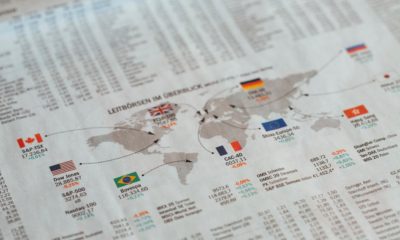Africa
Morocco’s Labor Market Situation in the 2nd Quarter of 2021
If the employment rate has increased slightly compared to the same period of 2020, from 39.3% to 40.2% at the national level (+0.9 points), it must be recognized that this increase has occurred mainly in rural areas. In urban areas, there has been a 0.7 point drop (35.6% to 34.9%). In any case, the employment rate remains below the level recorded before the pandemic (42.1% in the second quarter of 2019).

The latest figures on the labor market in Morocco in the second quarter of the current year, which were recently published by the HCP, are far from reassuring. With the exception of agriculture and construction, which have experienced some momentum, other activities are struggling to recover their level of 2019. Overall, the same characteristics of the labor market can be found, with insufficient activity and employment rates (especially for women), a predominance of workers without any diploma (nearly 50%), structural unemployment that affects mainly young graduates, and the persistence and even aggravation of the phenomenon of unpaid employment.
Thus, if the employment rate in Morocco has increased slightly compared to the same period of 2020, from 39.3% to 40.2% at the national level (+0.9 points), it must be recognized that this increase has occurred mainly in rural areas. In urban areas, on the other hand, there has been a 0.7 point drop (35.6% to 34.9%). In any case, the employment rate remains below the level recorded before the pandemic (42.1% in the second quarter of 2019). On the other hand, the volume of employment increased by 405,000 jobs, resulting from the creation of 414,000 jobs in rural areas and a loss of 9,000 in urban areas, compared to a loss of 589,000 in Q2 2020.
Read more about the labor market in Morocco and find the most important economic news in the world with the Born2Invest mobile app.
Of the 400,000 jobs created in the agricultural sector, only half are paid
As can be seen, the new job creations are due to the favorable climatic conditions that led to an exceptional agricultural campaign, with more than 103 million quintals, a record rarely reached. But again, of the 400,000 jobs created, just over half (215,000) are paid jobs. The rest (190,000) are unpaid jobs, in the form of family helpers and others. A kind of drudgery that does not say its name, in short! The persistence of this form of exploitation of the labor force, consisting mainly of young people and children, is a manifestation of the underdevelopment of our countryside, which has not received the same attention in public policies as modern capitalist agriculture.
Regarding the distribution of the working population by sector, of the 10,892,000 employed estimated in the 2nd quarter of 2021, the sector of “services” employs 45.2%, followed by “agriculture, forestry and fisheries” with 33.1%, “industry including handicrafts” with 11.1% (of which 44% are artisanal activities) and “construction” with 10.5%. Overall, nearly seven out of ten (70.7%) of the rural employed work in “agriculture, forestry and fishing”, and two-thirds of the urban employed (66.6%) work in the service sector.
This data confirms a previous remark about the “deformed” character of Moroccan capitalism: an under-equipped rural world and an urban world dominated by survival activities. Indeed, when we see two-thirds of the active population employed in “services”, there is reason to be seriously concerned. Industry, which is supposed to be a means of developing society and transforming structures, employs only 11% of the working population, including crafts, or barely 1.2 million people. Only 677,000 workers are employed in industry, strictly speaking, if we refer to the data of the HCP, which remains the authorized source on the subject.
Therefore, there is no point in putting forward fanciful figures that exist only in the imagination of their author, and thus give a truncated image of reality. The reality is as follows: between the second quarter of 2020 and the same period in 2021, the “industry including crafts” sector lost 53,000 jobs, compared to 69,000 last year, with, in parallel, an average annual creation of 32,000 jobs between the second quarters of the three years prior to the pandemic. The only sectors, apart from agriculture, that have created jobs are services and construction. Thus, the “services” sector has created 40,000 jobs, compared to a loss of 30,000 in the same period last year and an average of 149,000 between the second quarters of the three pre-pandemic years.
For its part, the construction sector has created 108,000 jobs, compared to a loss of 9,000 in the same period last year and an average annual loss of 27,000 jobs between the second quarters of the three pre-pandemic years. As for the number of unemployed, it increased by 128,000 between the second quarter of the year 2020 and that of 2021, from 1,477,000 unemployed to 1,605,000, which corresponds to an increase of 9%. This increase is the result of a reduction of 100,000 unemployed in rural areas and an increase of 228,000 in urban areas. In addition, there are almost one million people who are underemployed.
Regarding the unemployment rate, it has maintained its upward trend, recorded in the same period of the previous year. It increased by 0.5 percentage points between the second quarters of 2020 and 2021, from 12.3% to 12.8% at the national level, with a sharp increase in urban areas, from 15.6% to 18.2%, and a significant decrease in rural areas, from 7.2% to 4.8%. On the other hand, the unemployment rate worsened among graduates, rising by 2.2 points from 18.2% to 20.4% between the second quarters of 2020 and 2021.
The largest increase (three points) was among college graduates, with the rate rising from 22.3 percent to 25.3 percent. The unemployment rate of middle school graduates, on the other hand, increased by 1.8 points to 17.6%. In short, the problem of employment remains entirely unresolved. It could not, moreover, be otherwise as long as this question does not benefit from the interest which it deserves in the development and the implementation of public policies. In order to contain the problem of unemployment and create enough decent jobs, we need both the means and the will. In the Moroccan case, however, both conditions are far from being met. Thus, the means allocated to employment are insignificant, and incentives are distilled down to a trickle. Moreover, the country needs a strong political will to put employment at the center of public policies and to make it a priority.
__
(Featured image by AbsolutVision via Pixabay)
DISCLAIMER: This article was written by a third party contributor and does not reflect the opinion of Born2Invest, its management, staff or its associates. Please review our disclaimer for more information.
This article may include forward-looking statements. These forward-looking statements generally are identified by the words “believe,” “project,” “estimate,” “become,” “plan,” “will,” and similar expressions. These forward-looking statements involve known and unknown risks as well as uncertainties, including those discussed in the following cautionary statements and elsewhere in this article and on this site. Although the Company may believe that its expectations are based on reasonable assumptions, the actual results that the Company may achieve may differ materially from any forward-looking statements, which reflect the opinions of the management of the Company only as of the date hereof. Additionally, please make sure to read these important disclosures.
First published in LesEco.ma, a third-party contributor translated and adapted the article from the original. In case of discrepancy, the original will prevail.
Although we made reasonable efforts to provide accurate translations, some parts may be incorrect. Born2Invest assumes no responsibility for errors, omissions or ambiguities in the translations provided on this website. Any person or entity relying on translated content does so at their own risk. Born2Invest is not responsible for losses caused by such reliance on the accuracy or reliability of translated information. If you wish to report an error or inaccuracy in the translation, we encourage you to contact us.

-

 Cannabis2 weeks ago
Cannabis2 weeks agoCannabis Clubs Approved in Hesse as Youth Interest in Cannabis Declines
-

 Crowdfunding6 days ago
Crowdfunding6 days agoWorld4All, a Startup that Makes Tourism Accessible, Surpasses Minimum Goal in Its Crowdfunding Round
-

 Crypto3 days ago
Crypto3 days agoThe Crypto Market Rally Signals Possible Breakout Amid Political Support and Cautious Retail Sentiment
-

 Impact Investing2 weeks ago
Impact Investing2 weeks agoEuropeans Urge Strong Climate Action Amid Rising Awareness and Support

























